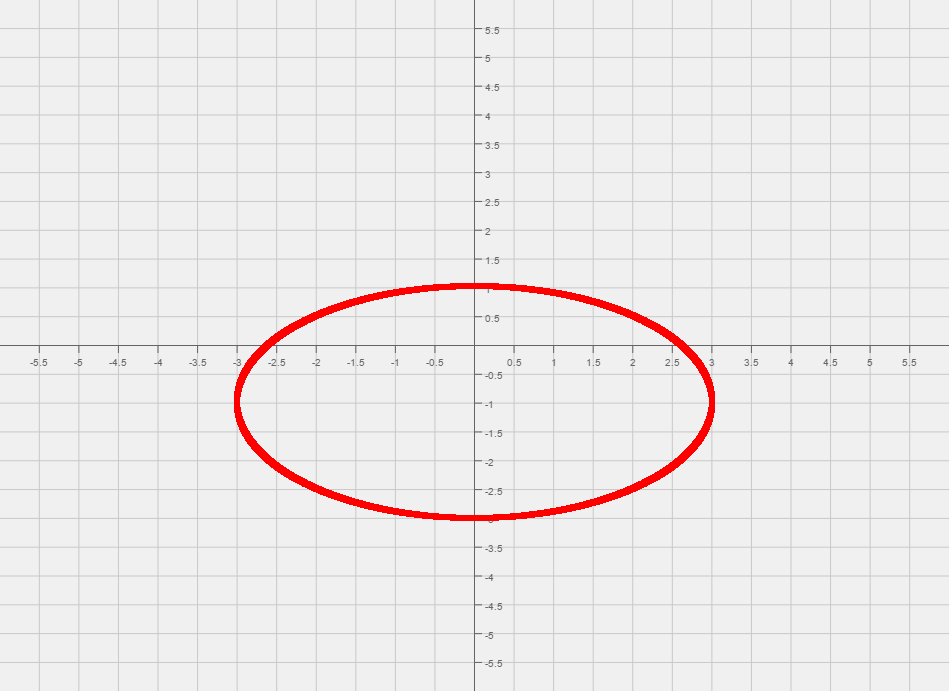Difference between revisions of "005 Sample Final A, Question 16"
Jump to navigation
Jump to search
(Created page with "'''Question ''' Graph the following, <center><math> -x^2+4y^2-2x-16y+11=0</math></center> {| class="mw-collapsible mw-collapsed" style = "text-align:left;" ! Final Answers |-...") |
|||
| Line 2: | Line 2: | ||
{| class="mw-collapsible mw-collapsed" style = "text-align:left;" | {| class="mw-collapsible mw-collapsed" style = "text-align:left;" | ||
| − | ! | + | !Foundations: |
|- | |- | ||
| − | | | + | |1) What type of function is this? |
|- | |- | ||
| − | | | + | |2) What can you say about the orientation of the graph? |
|- | |- | ||
| − | | | + | |Answer: |
|- | |- | ||
| − | | | + | |1) Since both x and y are squared it must be a hyperbola or an ellipse. We can conclude that the graph is an ellipse since both <math>x^2</math> and <math>y^2</math> have the same sign, positive. |
|- | |- | ||
| − | | | + | |2) Since the coefficient of the <math>x^2</math> term is smaller, when we divide both sides by 36 the X-axis will be the major axis. |
| + | |} | ||
| + | |||
| + | Solution: | ||
| + | |||
| + | {| class="mw-collapsible mw-collapsed" style = "text-align:left;" | ||
| + | ! Step 1: | ||
|- | |- | ||
| − | | | + | |We start by dividing both sides by 36. This yields <math>\frac{4x^2}{36} + \frac{9(y + 1)^2}{36} = \frac{x^2}{9} + \frac{(y+1)^2}{4} = 1</math>. |
| + | |} | ||
| + | |||
| + | {| class="mw-collapsible mw-collapsed" style = "text-align:left;" | ||
| + | ! Step 2: | ||
| + | |- | ||
| + | |Now that we have the equation that looks like an ellipse, we can read off the center of the ellipse, (0, -1). | ||
| + | |- | ||
| + | |From the center mark the two points that are 3 units left, and three units right of the center. | ||
| + | |- | ||
| + | |Then mark the two points that are 2 units up, and two units down from the center. | ||
| + | |} | ||
| + | |||
| + | {| class="mw-collapsible mw-collapsed" style = "text-align:left;" | ||
| + | ! Final Answer: | ||
| + | |- | ||
| + | |The four vertices are: <math>(-3, -1), (3, -1), (0, 1) \text{ and } (0, -3)</math> | ||
| + | |- | ||
| + | |[[File:8A_Sample_Final,_Q_6.png]] | ||
|} | |} | ||
[[005 Sample Final A|'''<u>Return to Sample Exam</u>''']] | [[005 Sample Final A|'''<u>Return to Sample Exam</u>''']] | ||
Revision as of 09:59, 2 June 2015
Question Graph the following,
| Foundations: |
|---|
| 1) What type of function is this? |
| 2) What can you say about the orientation of the graph? |
| Answer: |
| 1) Since both x and y are squared it must be a hyperbola or an ellipse. We can conclude that the graph is an ellipse since both and have the same sign, positive. |
| 2) Since the coefficient of the term is smaller, when we divide both sides by 36 the X-axis will be the major axis. |
Solution:
| Step 1: |
|---|
| We start by dividing both sides by 36. This yields . |
| Step 2: |
|---|
| Now that we have the equation that looks like an ellipse, we can read off the center of the ellipse, (0, -1). |
| From the center mark the two points that are 3 units left, and three units right of the center. |
| Then mark the two points that are 2 units up, and two units down from the center. |
| Final Answer: |
|---|
| The four vertices are: |

|




